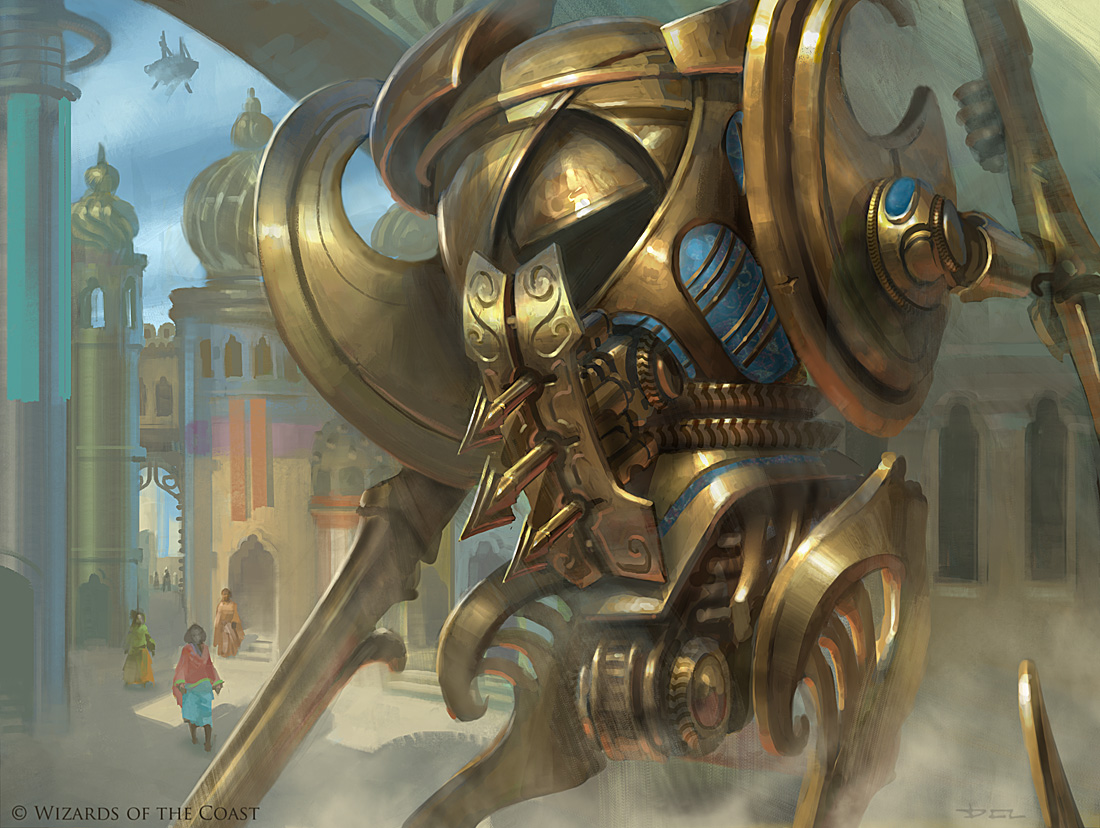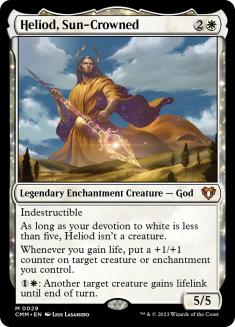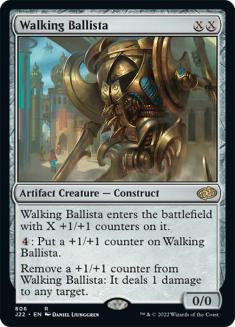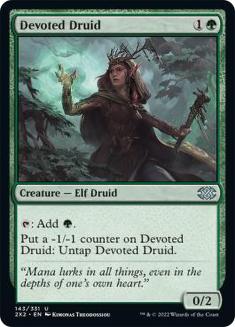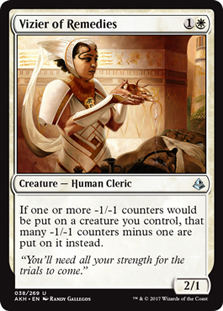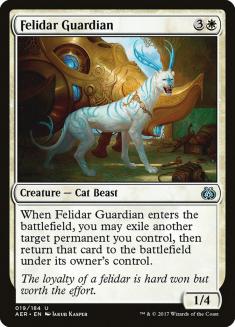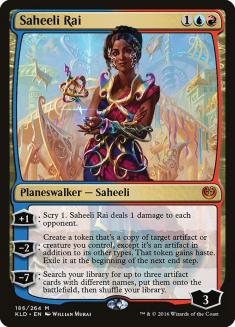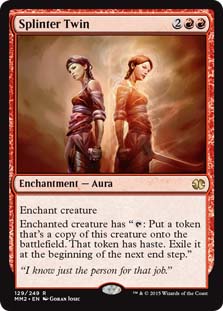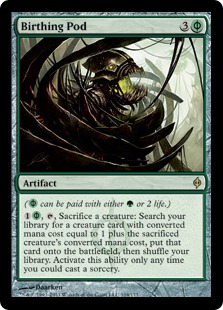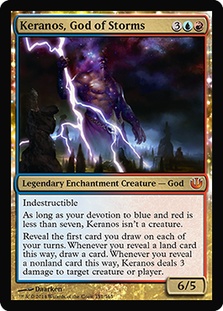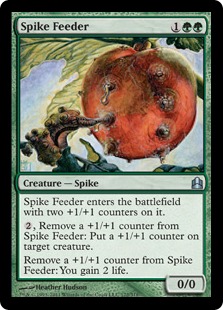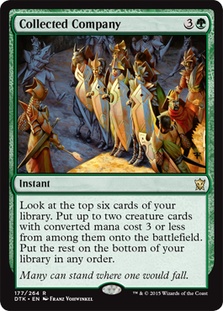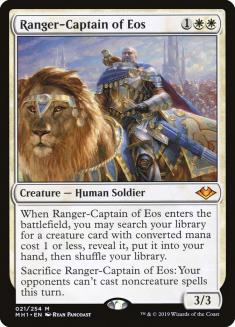Theros Beyond Death arrived last weekend, and we now enter the period where online play is rampant as we approach the first set of tournaments with the new set. Relative to the rampant hyperbole, both positive and negative, of preview season, now is the time for reality to set in as we collectively figure out which cards overperform and which fall flat.
Given my focus on non-rotating formats, the most hyped card from Theros Beyond Death has been Heliod, Sun-Crowned, entirely due to its potential combo with Walking Ballista.
In case you’ve been living under a rock, a Ballista with two or more +1/+1 counters can be given lifelink with Heliod, at which point activating its first ability will result in a damage dealt, a life gained, and thus a Heliod trigger to replace the counter. Lather, rinse, repeat, and you have as much damage as you want.
Any two-card combo that wins the game on the spot the vast majority of the time will garner attention. After all, the combo of Devoted Druid and Vizier of Remedies has seen steady play in Modern for years even though you need a third piece to convert the mana into a win. For Pioneer players, Felidar Guardian was among the first cards banned in the format due to its combo with Saheeli Rai. There’s precedent here which justifies the hype.
That said, as a combo, I find Heliod-Ballista to be significantly overrated. When evaluating combo decks in a vacuum, the three metrics I look at are speed, consistency, and resiliency. Since Walking Ballista is a poor target for tutors like Chord of Calling and Finale of Devastation, it’s surprisingly difficult to assemble the combo consistently without adding weak enablers like Commune with the Gods or Board the Weatherlight. Modern has Once Upon a Time, but that card is powerful enough to go into several decks, so you’re not gaining an edge on the field.
On the resilience axis, creature combo typically struggles because its pieces are easy to interact with. Decks like Lotus Field in Pioneer or Storm in Legacy blank their opponents’ creature removal, providing an edge in the pre-sideboard games. This combo catches a break here because Heliod is difficult to interact with, but Walking Ballista is quite easy to remove, especially when cast for X=2. You can try to play a game of chicken with your opponent, casting Walking Ballista with two mana left over and passing the turn, ready to respond to removal with a Heliod activation for the win, but that line of play isn’t available until you have six mana.
If six mana seems like it’s too slow to you, you’re not alone. It’s the speed axis on which Heliod-Ballista falls well short. Creature combo usually comes out well on this metric, which makes up for the sacrifice in resilience. Decks like Infect and Devoted Devastation are among the fastest in all of Modern, and that’s an important part of what makes them successful. Because you need at least two counters on Walking Ballista and two mana to activate the Heliod, you can’t combo on Turn 4 without some help from weak cards like Radiant Fountain or Anafenza, Kin-Tree Spirit.
That leaves you trying to assemble a three-card combo that is likely worse than Devoted Druid + Vizier of Remedies, or waiting until Turn 5 or 6 to kill your opponent. At that point, you’re not appreciably faster than Mono-Black Aggro and other top decks in Pioneer, much less the top decks in Modern. Simply put, I don’t want to build a straight combo deck around this shell.
The Importance of False Tempo
Fortunately, a straight combo shell isn’t the only path for Heliod-Ballista to shine in non-rotating formats. In fact, the most successful creature-based combo decks haven’t been linear shells. Instead, they’ve incorporated a strong secondary plan into a hybrid strategy that gains the benefit of false tempo.
For an in-depth treatment of the concept, consult Gerry Thompson’s seminal article on the topic here. For our purposes, I’ll define false tempo as the advantage generated by the threat of a combo rather than the combo itself.
Splinter Twin is the canonical example here. Starting from Turn 3 or 4, the opponent was forced to make the decision to hold up a removal spell for the combo or extend further to the battlefield. If you played too conservatively, the Twin deck’s control elements could bury you. If you played too aggressively, you might lose the game on the spot. Consistently putting the opponent into that tough spot was critical to Splinter Twin’s success.
And that concept has been carried over many times over. The old Birthing Pod decks could assemble Melira, Sylvok Outcast; Kitchen Finks; and Viscera Seer to gain a million life, or they could simply tutor for a chain of value creatures and win via attrition while the opponent is too afraid of using their removal. Felidar Guardian and Saheeli Rai have always been surrounded by a bunch of removal spells and planeswalkers to also play an effective midrange game while dangling the Sword of Damocles over its opponent the entire time.
The key here is that adding a secondary plan greatly increases your resilience to interaction. If you pull ahead in a fair game, your opponent is forced to use their removal or lose to your first wave, often leaving you free to run out the combo. Having a secondary plan also makes it harder for your opponent to sideboard effectively against the combo, since you can replace combo pieces with more robust threats. Splinter Twin was the best deck for this tactic, often sideboarding down to one or two copies of Splinter Twin and trying to strand the opponent with a pile of Abrupt Decays against their Keranos, God of Storms.
Going the false tempo route does require sacrifices in speed and consistency, but if the combo isn’t fast enough to begin with, you should take the added resilience. That’s where we have to take the Heliod-Ballista combo in order to succeed in formats as powerful as Pioneer and Modern.
Utilizing Combo Pieces in a Fair Plan
The key to finding the right secondary plan for a combo is to maximize the power of the combo pieces themselves when fighting fair. Splinter Twin did this with the creatures, Deceiver Exarch and Pestermite, playing defense or pecking away in control mirrors, while Felidar Guardian has blinked plenty of Oath of Nissas and Rogue Refiners in its day.
On the other hand, not finding a great shell to utilize Devoted Druid and Vizier of Remedies on their own has been the most significant factor holding that combo back in Modern. I preferred Selesnya Elves as a shell for the combo over the traditional Counters Company lists precisely because it had a robust plan that utilized Devoted Druid well, and thus only needed one copy of Vizier of Remedies. Unfortunately, overloading on removal was a good tactic against both sides of the deck, which limited its effectiveness to removal-light metagames.
Spell-based combo is much more all or nothing in that when the combo doesn’t come together you have no chance, but when your pieces are creatures there’s always the out of turning them sideways.
Looking at our two combo pieces, Walking Ballista already has a strong pedigree, though we mostly find it in decks that generate a ton of mana like Eldrazi Tron and Mono-Green Devotion, or decks that synergize with +1/+1 counters like Hardened Scales or Walking Ballista in Standard a few years ago.
Heliod, Sun-Crowned is brand new, and thus has no pedigree. But Thassa, God of the Sea is similarly templated and was a staple in Theros Standard. I expect Heliod to perform similarly well in Standard decks that can consistently get to five devotion to turn it on, and if that’s something that interests you, Gerry Thompson has some good starting points here.
What worries me in older formats is whether the cards we’re playing to enable Heliod are good enough to fill out a deck, because using Thassa as our guide, we’re going to need a ton of white symbols to make it work.
I tried a White Devotion list in Pioneer on VS Live! that showed some promise but is seriously lacking on the low end of the curve. Aspiringspike has had some success with a similar list on his stream:
Notably, these lists make little effort to increase the consistency of the combo, as my copies of Board the Weatherlight were easily the worst cards in the deck and should be cut for something more impactful. The combo plan is actually secondary, so these decks should be evaluated on the strength of their midrange game. On this metric, Mono-White Devotion looks to match up well against aggro strategies, but don’t have the same clock against control and ramp that Mono-Black Aggro or Chonky Red with its Goblin Rabblemasters enjoy.
The Best Heliod-Ballista Deck I’ve Seen
Creatures (32)
- 2 Birds of Paradise
- 4 Spike Feeder
- 4 Kitchen Finks
- 4 Noble Hierarch
- 2 Viscera Seer
- 3 Anafenza, Kin-Tree Spirit
- 1 Walking Ballista
- 4 Giver of Runes
- 4 Ranger-Captain of Eos
- 4 Heliod, Sun-Crowned
Lands (20)
Spells (8)
Sideboard

This list took third place last weekend in the Modern Challenge, and while I was surprised to see the combo break through so quickly, I wasn’t surprised after reviewing the list.
Playing a straight devotion shell is even more dubious in Pioneer, so this list sacrifices Walking Ballista as a major element of the deck to focus more on Heliod, and as a result I think Arongomu has created something very promising.
Winning the game on the spot is nice, but gaining a billion life effectively wins the game against most decks, or at least will afford you plenty of time to find the one Walking Ballista. The combo between Heliod and Spike Feeder is much cleaner, since it doesn’t require a Heliod activation. You can cast the cards on Turns 3 and 4 (2 and 3 if you have a mana creature) and be done with it.
Also, this pairing has the added advantage of both pieces playing nicely with Collected Company, so even with no battlefield, four open mana represents the potential to assemble the combo. The threat of going from nothing to everything is the ideal recipe to leverage false tempo. So many opponents will hold up removal rather than establish their own battlefield, offering you extra time to leverage the aggressive elements in the deck.
And these aggressive elements tie everything together. Kitchen Finks isn’t quite what it used to be, but it’s great at providing devotion, and when you have Heliod on the battlefield, you’ll get a trigger when it persists, adding a counter to the Finks that effectively resets it. Anafenza, Kin-Tree Spirit is a weaker enabler for the same synergy, but offering devotion and functioning as a combo piece with the black splash for Viscera Seer makes it just good enough.
Ranger-Captain of Eos is the real linchpin. It does so many little things for the deck while still being a solid card on its own. It’s two devotion for Heliod. It provides card advantage in the face of heavy removal. It finds your one Walking Ballista so you can more consistently kill people without overloading on the weakest combo piece. And lastly, its activated ability clears a path to resolve your Walking Ballista and protect it from removal.
Heliod offers this deck the robust backup plan it has lacked since the days of Birthing Pod. It’s effectively an improved Archangel of Thune, since it’s much cheaper and can be found off Collected Company. Between Company and Once Upon a Time, you don’t need the perennially overrated Chord of Calling and the end result is a sleek, efficient machine.
Creature-combo is among my favorite macro-archetypes in Magic. Spell-based combo is much more all or nothing in that when the combo doesn’t come together you have no chance, but when your pieces are creatures there’s always the out of turning them sideways. Heliod may just be the single best aggro plan for a creature-combo deck we’ve seen, and I’ll be watching closely to see how it develops.

